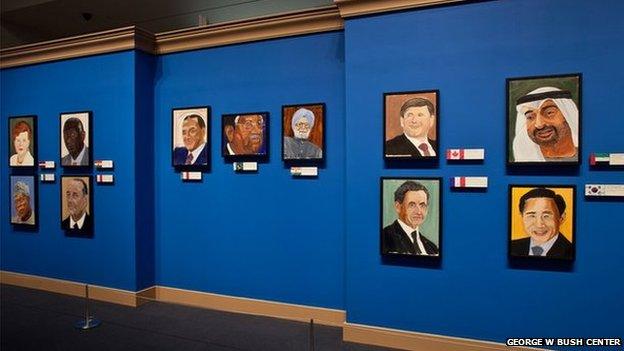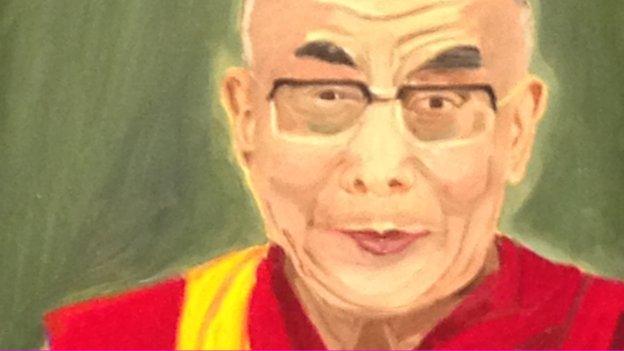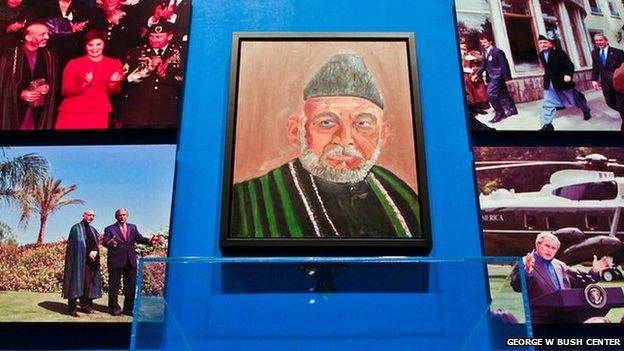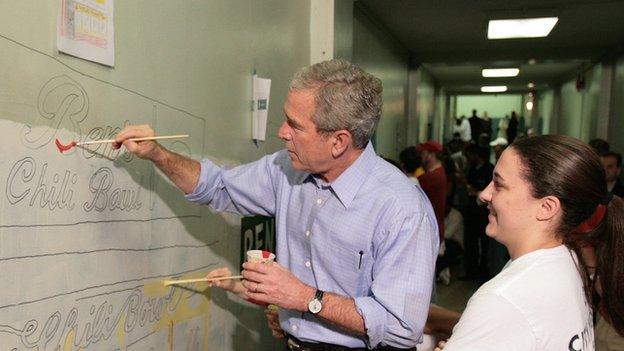George W Bush exhibits his paintings of world leaders
- Published
George W Bush said he could only paint these portraits because he got know the leaders so intimately
On Saturday, former US President George W Bush, who has said he is admittedly "not a great painter", opens a public exhibit of his works - more than 24 portraits of world leaders he met while president. The BBC's Nick Bryant has a preview of the gallery.
For a president long criticised for seeing things only in black and white, the exhibition of George W Bush's art at his presidential library in Dallas comes as something of a revelation.
Delicate brushwork has replaced his famed swagger. He presents himself as a wholly different kind of Texas oilman. With each new brushstroke he seems also to be softening his public image.
George W Bush told his art teacher, whom he meets on a weekly basis, to unleash the ex-president's inner Rembrandt, and the results are now on public display: a deeply personal gallery of world leaders, focusing on the art of personal diplomacy.
His vantage point, of course, is unique: the cockpit of the presidency - or, at least, his recollection of those tumultuous White House years. So there is more to them than canvas, paints and brushes. Another key ingredient is personal chemistry.

The exhibition features paintings of more than 24 world leaders
His portrait of Tony Blair, which is bereft of the former British prime minister's trademark toothy smile, was intended to portray compassion, strength and reliability.
His Angela Merkel shows a more cheery side to the German chancellor than her sometimes grumpy public persona projects.
And maybe his Dalai Lama reveals more about the former president himself, as he enters a more contemplative and cloistered phase of his life. In art, he appears to locate an inner serenity.
But perhaps the most eagerly anticipated portrait is that of the Russian president, Vladimir Putin.
During their first meeting, in Slovenia in 2001, Mr Bush came close to claiming he could read the former KGB spymaster like a book.
"I looked the man in the eye," he famously said. "I was able to get a sense of his soul."

German Chancellor Angela Merkel is among the world leaders featured by the former president in his portraits
But here he is rendered as a poker-faced Putin, more enigmatic and unreadable.
There's a coldness to the portrait of a leader whom Mr Bush referred to privately as "Pootie Poot".
Mr Bush, or "43" as he signs each canvas, reckons this to be his finest work.
Perhaps the most unflattering portrait is that of the former Pakistan president, General Pervez Musharraf, a leader who liked to think of himself as a dashing former paratrooper rather than the tired and bloated figure represented here.
The extravagant bouffant, of which the general was justifiably proud, does not even make it into frame.
Maybe this is a form of artistic revenge. After all, when it came to fighting al-Qaeda and hunting down Osama Bin Laden, the Bush administration always suspected Islamabad of playing a double game: accepting American military aid but of not doing enough to flush out the mastermind of 9/11.
Nor is the outgoing Afghan president Hamid Karzai portrayed in a complimentary light. This, again, was a fraught relationship.

Mr Bush said the Dalai Lama is "a very sweet man, and I painted him as sweetly as I could"
Making these kinds of extrapolations is part of the fun of this exhibition. Far from being declarative, it can be interpreted in so many different ways.
So is it possible to read into this work a subtle dig at the man who succeeded him as president?
George W Bush says his portraits would not have been possible had he not invested so much time in personal diplomacy.
He got to know the family details of international leaders - those useful conversation points. Many of them, like Tony Blair and the former Australian prime minister John Howard, were invited into the inner sanctum of his Texan ranch.
Barack Obama's approach is noticeably less chummy. He is often criticised as being more aloof and of not investing enough effort in working on the personal chemistry that can reap diplomatic dividends.
For those of us who covered the Bush presidency, from the golf rounds to the mountain-bike riding, from the brush clearing to that Top Gun moment in the aftermath of the fall of Baghdad, his newfound hobby is an improbable departure.

Mr Bush worked closely with President Hamid Karzai during the Afghan war
But he paints every day, gets a lesson every week and says his inspiration came from his great hero Sir Winston Churchill.
Those who interacted closely with Mr Bush during his White House years reckon he was unrecognisable from the two-dimensional figure who lent himself to such easy caricature.
Certainly, his artwork has added an extra and unexpected side.
- Published26 February 2014
